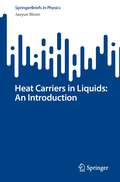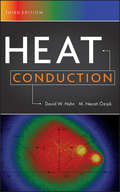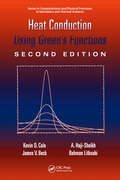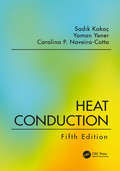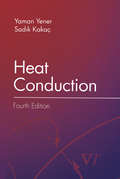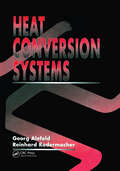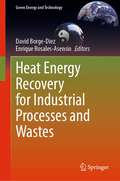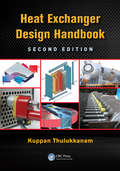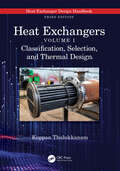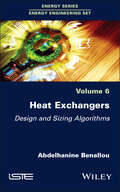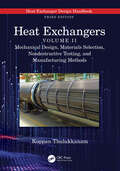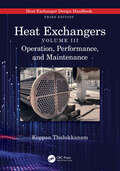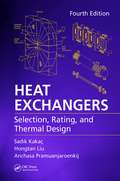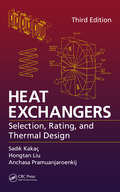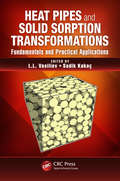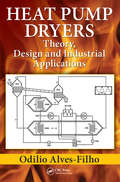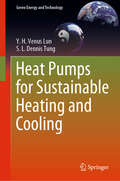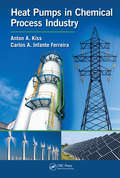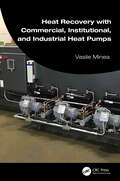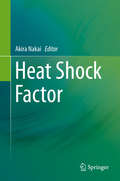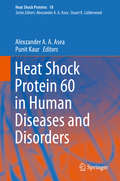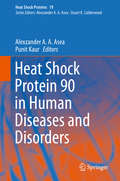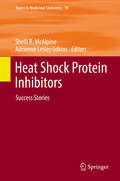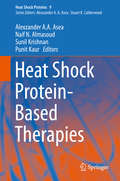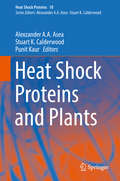- Table View
- List View
Heat Carriers in Liquids: An Introduction (SpringerBriefs in Physics)
by Jaeyun MoonThis book provides a succinct overview of recent progress in characterization of heat carriers describing atomic motion in liquids. Unlike solids and gases where heat carriers are typically described by phonons and real atomic particles, the nature of effective heat carriers in liquids is still elusive. The emphasis is on two widely used spectral methods to describe heat carriers: instantaneous normal modes and velocity autocorrelation functions. Various bulk materials properties from a bottom-up perspective using these spectra are presented in detail. This book is an ideal introduction to the field for graduate students and young researchers.
Heat Conduction
by David W. Hahn M. Necati OzisikThe long-awaited revision of the bestseller on heat conduction Heat Conduction, Third Edition is an update of the classic text on heat conduction, replacing some of the coverage of numerical methods with content on micro- and nanoscale heat transfer. With an emphasis on the mathematics and underlying physics, this new edition has considerable depth and analytical rigor, providing a systematic framework for each solution scheme with attention to boundary conditions and energy conservation. Chapter coverage includes: Heat conduction fundamentals Orthogonal functions, boundary value problems, and the Fourier Series The separation of variables in the rectangular coordinate system The separation of variables in the cylindrical coordinate system The separation of variables in the spherical coordinate system Solution of the heat equation for semi-infinite and infinite domains The use of Duhamel's theorem The use of Green's function for solution of heat conduction The use of the Laplace transform One-dimensional composite medium Moving heat source problems Phase-change problems Approximate analytic methods Integral-transform technique Heat conduction in anisotropic solids Introduction to microscale heat conduction In addition, new capstone examples are included in this edition and extensive problems, cases, and examples have been thoroughly updated. A solutions manual is also available. Heat Conduction is appropriate reading for students in mainstream courses of conduction heat transfer, students in mechanical engineering, and engineers in research and design functions throughout industry.
Heat Conduction Using Greens Functions (Series in Computational Methods and Physical Processes in Mechanics and Thermal Sciences)
by James Beck A. Haji-Sheikh Bahman Litkouhi Kevin ColeSince its publication more than 15 years ago, Heat Conduction Using Green's Functions has become the consummate heat conduction treatise from the perspective of Green's functions-and the newly revised Second Edition is poised to take its place. Based on the authors' own research and classroom experience with the material, this book organizes the so
Heat Conduction, Fifth Edition
by Yaman Yener Carolina P. Naveira-Cotta Sadık KakacHeat Conduction, Fifth Edition, upholds its reputation as the leading text in the field for graduate students, and as a resource for practicing engineers. The text begins with fundamental concepts, introducing the governing equation of heat conduction, and progresses through solutions for one-dimensional conduction, orthogonal functions, Fourier series and transforms, and multi-dimensional problems. Integral equations, Laplace transforms, finite difference numerical methods, and variational formulations are then covered. A systematic derivation of the analytical solution of heat conduction problems in heterogeneous media, introducing a more general approach based on the integral transform method, has been added in this new edition, along with new and revised problems, and complete problem solutions for instructors.
Heat Conduction, Fourth Edition
by Yaman Yener Sadik KakacNearly thirty years since its first publication, the highly anticipated fourth edition of Heat Conduction upholds its reputation as an instrumental textbook and reference for graduate students and practicing engineers in mechanical engineering and thermal sciences. Written to suit a one-semester graduate course, the text begins with fundamental concepts, introducing the governing equation of heat conduction as derived from the First law of Thermodynamics. Solutions for one-dimensional conduction follow, then orthogonal functions, Fourier series and transforms, and multi-dimensional problems. Later sections focus on a series of specialized techniques, including integral equations, Laplace transforms, finite difference numerical methods, and variational formulations. Two new chapters (9 and 11) have been added to cover heat conduction with local heat sources and heat conduction involving phase change. Applications of Fourier transforms in the semi-infinite and infinite regions have been added to Chapter 7 and Chapter 10 has been expanded to include solutions by the similarity method. Also new to the fourth edition are additional problems at the end of each chapter.
Heat Conversion Systems
by Reinhard Radermacher Georg AlefeldHeat Conversion Systems develops the underlying concepts of advanced Rankine-based absorption and compression cycles and introduces the Building Block Approach as a general concept. The Building Block Approach identifies all cycle configurations for a given application to ensure that system designers have available all important alternatives. The book features numerous examples of advanced cycles and includes single- and multi-stage absorption heat pumps and heat transformers and combined systems. The book also discusses single- and multi-stage vapor compression systems with multiple solution circuits, multiple compressors, and cascades. Aspects of working fluid selection and their influence on cycle options, performance evaluation, and estimating procedures for the Coefficient of Performance (COP) are addressed. Cycle analysis based on the Second Laws of Thermodynamics is examined. Heat Conversion Systems will be an important source for engineers in air-conditioning, heat pumping, refrigeration, and waste heat utilization. It can be used as text in courses on thermodynamics, efficient use of energy, and environmental protection.
Heat Energy Recovery for Industrial Processes and Wastes (Green Energy and Technology)
by Enrique Rosales-Asensio David Borge-DiezThis book provides new techniques for recovering exhaust heat from gas turbines, natural gas combined cycle power plants, biomass boilers, and waste heat recovery from compost and wastewater treatment plants The book provides modeling for the study and comparison of combined cycle power plants with a heat recovery boiler of three pressure levels with reheating, inserting a technological improvement of solar hybridization and partial regeneration in the gas turbine. It assesses the environmental impacts and economic sustainability associated with these improvements. In addition, it proposes emissions minimization, with exhaust gas recirculation (EGR), and emissions treatment with a CO2 capture plant (CCP) and combined cycle power plant. Finally, it provides new insights into heat recovery from compost and exhaust gases recovery from wastewater treatment plants.
Heat Exchanger Design Handbook (Mechanical Engineering)
by Kuppan ThulukkanamCompletely revised and updated to reflect current advances in heat exchanger technology, Heat Exchanger Design Handbook, Second Edition includes enhanced figures and thermal effectiveness charts, tables, new chapter, and additional topics--all while keeping the qualities that made the first edition a centerpiece of information for practicing engine
Heat Exchangers: Classification, Selection, and Thermal Design
by Kuppan ThulukkanamHeat Exchangers: Classification, Selection, and Thermal Design, Third Edition discusses heat exchangers and their various applications, such as refrigeration, air conditioning, automobiles, gas turbines, process industries, refineries, and thermal power plants.With a focus on thermal design methods, including rating and sizing, the book covers thermohydraulic fundamentals and thermal effectiveness charts for various flow configurations and shell and tube heat exchangers. It provides construction details, geometrical features and correlations, and thermo-hydraulic details for tube-fin, plate fin, air-cooled, shell and tube, microchannel, and plate heat exchangers and thermal design methods like rating and sizing. The book explores additive manufacturing of heat exchangers, printed circuit heat exchangers, and heat transfer augmentation methods. The book also describes recuperators and regenerators of gas turbine cycles, waste heat recovery devices, and phase change phenomena including boiling, condensation and steam generation.The book serves as a useful reference for researchers, graduate students, and engineers in the field of heat exchanger design, including heat exchanger manufacturers.
Heat Exchangers: Design and Sizing Algorithms
by Abdelhanine BenallouThe last few decades have seen huge developments in the use of concentrated solar power plants, communications technologies (mobile telephony and 5G networks), the nuclear sector with its small modular reactors and concentrated solar power stations. These developments have called for a new generation of heat exchangers. As well as presenting conventional heat exchangers (shell-and-tube and plate heat exchangers), their design techniques and calculation algorithms, Heat Exchangers introduces new-generation compact heat exchangers, including printed circuit heat exchangers, plate-fin heat exchangers, spiral heat exchangers, cross-flow tube-fin heat exchangers, phase-change micro-exchangers, spray coolers, heat pipe heat exchangers and evaporation chambers. This new generation of heat exchangers is currently undergoing a boom, with applications in on-board equipment in aircraft, locomotives, space shuttles and mobile phones, where the volume of the equipment is one of the most important design parameters.
Heat Exchangers: Mechanical Design, Materials Selection, Nondestructive Testing, and Manufacturing Methods
by Kuppan ThulukkanamHeat Exchangers: Mechanical Design, Materials Selection, Nondestructive Testing, and Manufacturing Methods, Third Edition covers mechanical design of pressure vessels and shell and tube heat exchangers, including bolted flange joint design, as well as selection of a wide spectrum of materials for heat exchanger construction, their physical properties, corrosion behavior, and fabrication methods like welding.Discussing the basics of quality control, the book includes ISO Standards for QMS, and references modern quality concepts such as Kaizen, TPM, and TQM. It presents Six Sigma and Lean tools, for heat exchangers manufacturing industries. The book explores heat exchanger manufacturing methods such as fabrication of shell and tube heat exchangers and brazing and soldering of compact heat exchangers.The book serves as a useful reference for researchers, graduate students, and engineers in the field of heat exchanger design, including pressure vessel manufacturers.
Heat Exchangers: Operation, Performance, and Maintenance
by Kuppan ThulukkanamHeat Exchangers: Operation, Performance, and Maintenance, Third Edition covers heat exchanger installation, commissioning and operation, and maintenance and performance monitoring in service.Focusing on in-service issues like flow-induced vibration, corrosion, and corrosion control, and fouling and fouling control, the book explores performance deterioration in service, maintenance issues, defects, tube failures, and how to detect these issues with NDT methods. It discusses various cleaning processes and repair methods. The book also considers boilers, utility boilers, coal-based thermal power plants, boiler corrosion, and boiler degradation mechanisms. It discusses different types of cooling systems, feedwater treatment, deaerators, feedwater heaters, economizers, condensers, cooling towers, and cooling-water management.The book serves as a useful reference for researchers, graduate students, power plant engineers, and engineers in the field of heat exchanger design, including pressure vessel manufacturers.
Heat Exchangers: Selection, Rating, and Thermal Design, Fourth Edition
by Sadik Kakaç Hongtan Liu Anchasa PramuanjaroenkijHeat exchangers are essential in a wide range of engineering applications, including power plants, automobiles, airplanes, process and chemical industries, and heating, air-conditioning, and refrigeration systems. Revised and fully updated with new problem sets, Heat Exchangers: Selection, Rating, and Thermal Design, Fourth Edition presents a systematic treatment of heat exchangers, focusing on selection, thermal-hydraulic design, and rating. Topics discussed include Classification of heat exchangers Basic design methods of heat exchangers for sizing and rating problems Single-phase forced convection correlations for heat exchangers Pressure drop and pumping power for heat exchangers and piping circuits Design methods of heat exchangers subject to fouling Thermal design methods and processes for double-pipe, shell-and-tube, gasketed-plate, compact, and polymer heat exchangers Two-phase convection correlations for heat exchangers Thermal design of condensers and evaporators Micro/nanoheat transfer The Fourth Edition contains updated information about microscale heat exchangers and the enhancement heat transfer for applications to heat exchanger design and experiment with nanofluids. The Fourth Edition is designed for courses/modules in process heat transfer, thermal systems design, and heat exchanger technology. This text includes full coverage of all widely used heat exchanger types. A complete solutions manual and figure slides of the text’s illustrations are available for qualified adopting instructors.
Heat Exchangers: Selection, Rating, and Thermal Design, Third Edition
by Sadik Kakac Hongtan Liu Anchasa PramuanjaroenkijHeat exchangers are essential in a wide range of engineering applications, including power plants, automobiles, airplanes, process and chemical industries, and heating, air conditioning and refrigeration systems. Revised and updated with new problem sets and examples, Heat Exchangers: Selection, Rating, and Thermal Design, Third Edition presents a
Heat Pipes and Solid Sorption Transformations: Fundamentals and Practical Applications
by Sadik Kakaç L. L. VasilievDeveloping clean energy and utilizing waste energy has become increasingly vital. Research targeting the advancement of thermally powered adsorption cooling technologies has progressed in the past few decades, and the awareness of fuel cells and thermally activated (heat pipe heat exchangers) adsorption systems using natural refrigerants and/or alt
Heat Pump Dryers: Theory, Design and Industrial Applications
by Odilio Alves-FilhoExplore the Social, Technological, and Economic Impact of Heat Pump DryingHeat pump drying is a green technology that aligns with current energy, quality, and environmental concerns, and when compared to conventional drying, delivers similar quality at a lower cost. Heat Pump Dryers: Theory, Design and Industrial Applications details the progressio
Heat Pumps for Sustainable Heating and Cooling (Green Energy and Technology)
by Y. H. Lun S. L. TungThis book highlights the significance of using sustainable energy to prevent the deterioration of our planet using heat pumps. Energy sustainability can be achieved through improved energy efficiency. In this regard, heat pumps offer an energy-efficient alternative for heating and cooling. To drive the adoption of heat pumps as a key component of sustainable buildings, the authors focus on examining sustainable practices in heat pump operations and innovative system design. In view of the growing desire to use sustainable energy to meet heating and cooling demands and improve indoor air quality, this book offers a valuable reference guide to the available options in HVAC (heating, ventilation, and air-conditioning) system design. To begin with, the authors define sustainable energy and discuss the trend of “thinking green” in building design. They then discuss sustainable practices and heat pump applications in mapping out HVAC systems. In turn, they examine the use of green operations to promote sustainable practices and, in order to highlight the importance of innovative design, discuss the configuration options and precision control aspects. In closing, the authors illustrate innovative sustainable design on the basis of several energy-efficient cases. The book’s main goal is to drive the adoption of sustainable energy solutions. Heat pumps, it argues, represent the most efficient system for meeting commercial/recreational/residential heating and cooling demands. The book not only examines industrial practices in heat pump application, but also discusses advanced heat pump technologies and innovative heat pump designs.
Heat Pumps in Chemical Process Industry
by Anton A. Kiss Carlos A. Infante FerreiraAs the chemical process industry is among the most energy demanding sectors, chemical engineers are endeavoring to contribute towards sustainable future. Due to the limitation of fossil fuels, the need for energy independence, as well as the environmental problem of the greenhouse gas effect, there is a large increasing interest in the research and development of chemical processes that require less capital investment and reduced operating costs and lead to high eco-efficiency. The use of heat pumps is a hot topic due to many advantages, such as low energy requirements as well as an increasing number of industrial applications. Therefore, in the current book, authors are focusing on use of heat pumps in the chemical industry, providing an overview of heat pump technology as applied in the chemical process industry, covering both theoretical and practical aspects: working principle, applied thermodynamics, theoretical background, numerical examples and case studies, as well as practical applications. The worked-out examples have been included to instruct students, engineers and process designers about how to design various heat pumps used in the industry. Reader friendly resources namely relevant equations, diagrams, figures and references that reflect the current and upcoming heat pump technologies, will be of great help to all readers from the chemical and petrochemical industry, biorefineries and other related areas.
Heat Recovery with Commercial, Institutional, and Industrial Heat Pumps
by Vasile MineaHeat Recovery with Commercial, Institutional, and Industrial Heat Pumps presents the basic concepts and thermodynamic behavior of mechanical vapor compression and recompression. It covers both ammonia water absorption and compression/resorption heat pumps.Including theoretical and practical approaches, the book features numerous solved exercises based on real thermodynamic and climatic parameters and case studies with takeaways from on-site experiences to help the reader better identify the advantages and limitations of each heat pumping technology. The book discusses future implementations of heat recovery heat pump technologies that are among the most energy-efficient and environmentally friendly techniques.This book will interest graduate students studying HVAC, thermal systems, and heat pumps. It will also benefit professionals working with heat pumps, industrial process engineers, manufacturers, and research and design personnel.
Heat Shock Factor
by Akira NakaiThis book presents a large amount of information related to the heat shock response and heat shock factor (HSF), describes core observations about molecular mechanisms and pathophysiological roles, and provides fundamental concepts on the basis of information from diverse aspects. This adaptive response to high temperature or protein misfolding is a fundamental mechanism to maintain the capacity of protein homeostasis, or proteostasis, and is evolutionally conserved among all living organisms, including bacteria and humans, on the earth. Furthermore, physiological and pathological roles of HSF have been extensively studied in fruit fly, worm, and mouse models. It has been revealed that HSF plays roles in development of the brain, reproductive and sensory organs, and in ageing, inflammation, and circadian rhythm. Analysis of the mechanisms have uncovered that HSF exerts a wide range of effects on gene expression and epigenetic status on the whole genome. Moreover, loss or gain of HSF function is also closely related to protein-misfolding diseases including neurodegenerative diseases, psychiatric diseases, heart diseases, and cancers. Therefore, HSF is now thought to be a promising therapeutic target for treatment of these refractory diseases. For undergraduate students, this is a highly understandable source of information on heart shock response and HSF, covering the basis of HSF biology, the physiological role of HSF, and disease associated with HSF function. This book not only serves as a guide to the heat shock response and HSF for students and young researchers in other fields, but also is a cornerstone for future work in the field related to the heat shock response and HSF.
Heat Shock Protein 60 in Human Diseases and Disorders (Heat Shock Proteins #18)
by Alexzander A. A. Asea Punit KaurThe book Heat Shock Protein 60 in Human Diseases and Disorders provides the most comprehensive review on contemporary knowledge on the role of HSP60 in human diseases and disorders. Using an integrative approach, the contributors provide a synopsis of novel mechanisms and signal transduction pathways. To enhance the ease of reading and comprehension the book has further been subdivided into various section including; Section I: Biomolecular Aspects of HSP60; Section II: HSP60 and Cancer; Section III: HSP60 and Inflammatory Diseases and Disorders; Section IV: HSP60 and Cardiovascular Diseases and Disorders; Section V: HSP60 and Neurological and Neurosciences; Section VI: Biomolecular Aspects of HSP60; Section VII: HSP60 and Skeletal Muscle Diseases and Disorders; and Section VIII: HSP60 in Human Health.Key basic and clinical research laboratories from major universities, academic medical hospitals, biotechnology and pharmaceutical laboratories around the world have contributed chapters that review present research activity and importantly project the field into the future. The book is a must read for graduate students. medical students, basic science researchers and postdoctoral scholars in the fields of Translational Medicine, Clinical Research, Human Physiology, Biotechnology, Neurology & Neuroscience, Oncology, Cardiovascular Disease, Skeletal Muscle Diseases and Disorders, Cell & Molecular Medicine, Pharmaceutical Scientists and Researchers involved in Drug Discovery.
Heat Shock Protein 90 in Human Diseases and Disorders (Heat Shock Proteins #19)
by Alexzander A. A. Asea Punit KaurThe book Heat Shock Protein 90 in Human Diseases and Disorders provides the most comprehensive review on contemporary knowledge on the role of HSP90. Using an integrative approach, the contributors provide a synopsis of novel mechanisms, previously unknown signal transduction pathways. To enhance the ease of reading and comprehension, this book has been subdivided into various section including; Section I, reviews current progress on our understanding Oncogenic Aspects of HSP90; Section II, focuses on Bimolecular Aspects of HSP90; Section III, emphasizes and HSP90 in Natural Products Development and Section IV; give the most up to date reviews on Clinical Aspects of HSP90. Key basic and clinical research laboratories from major universities, academic medical hospitals, biotechnology and pharmaceutical laboratories around the world have contributed chapters that review present research activity and importantly project the field into the future. The book is a must read for starters and professionals in the fields of Translational Medicine, Clinical Research, Human Physiology, Biotechnology, Natural Products, Cell & Molecular Medicine, Pharmaceutical Scientists and Researchers involved in Drug Discovery.
Heat Shock Protein Inhibitors
by Adrienne Lesley Edkins Shelli R. McalpineMedicinal chemistry is both science and art. The science of medicinal chemistry offers mankind one of its best hopes for improving the quality of life. The art of medicinal chemistry continues to challenge its practitioners with the need for both intuition and experience to discover new drugs. Hence sharing the experience of drug research is uniquely beneficial to the field of medicinal chemistry. Drug research requires interdisciplinary team-work at the interface between chemistry, biology and medicine. Therefore, the topic-related series Topics in Medicinal Chemistry covers all relevant aspects of drug research, e. g. pathobiochemistry of diseases, identification and validation of (emerging) drug targets, structural biology, drugability of targets, drug design approaches, chemogenomics, synthetic chemistry including combinatorial methods, bioorganic chemistry, natural compounds, high-throughput screening, pharmacological in vitro and in vivo investigations, drug-receptor interactions on the molecular level, structure-activity relationships, drug absorption, distribution, metabolism, elimination, toxicology and pharmacogenomics. In general, special volumes are edited by well known guest editors.
Heat Shock Protein-Based Therapies
by Alexzander A. A. Asea Naif N. Almasoud Sunil Krishnan Punit KaurThe book Heat Shock Protein-Based Therapies provides the most up-to-date review on new heat shock protein-based mechanisms used in the therapy and treatment of various human disorders and diseases, including cancer, muscular atrophy, neurodegenerative disorders (Alzheimer's Disease, Multiple Sclerosis) and infectious diseases (HIV, periodontal disease). Written by leaders in the field of heat shock protein research, the chapters systematically and in a step wise fashion takes the reader through the fascinating sequence of events by which mechanisms dependent on heat shock proteins are targeted. The chapters also provide answers as to HSP biological significance to the host. This book is a must read for graduate and postgraduates in the field of Drug Development, Biotechnology, Pharmaceutical Industry, Phytomedicine, Biology (plant and mammal), Biochemistry (pro- and eukaryotic), Oncology, Immunology, Microbiology, Exercise Medicine, Physiology, Inflammatory diseases, Autoimmunity, Pharmacology and Pathology.
Heat Shock Proteins and Plants
by Stuart K. Calderwood Alexzander A. A. Asea Punit KaurHeat Shock Proteins and Plants provides the most up-to-date and concise reviews and progress on the role of heat shock proteins in plant biology, structure and function and is subdivided into chapters focused on Small Plant HSPs (Part I), Larger Plant HSPs (Part II) and HSPs for Therapeutic Gain (Part III). This book is written by eminent leaders and experts from around the world and is an important reference book and a must-read for undergraduate, postgraduate students and researchers in the fields of Agriculture, Botany, Crop Research, Plant Genetics and Biochemistry, Biotechnology, Drug Development and Pharmaceutical Sciences.
